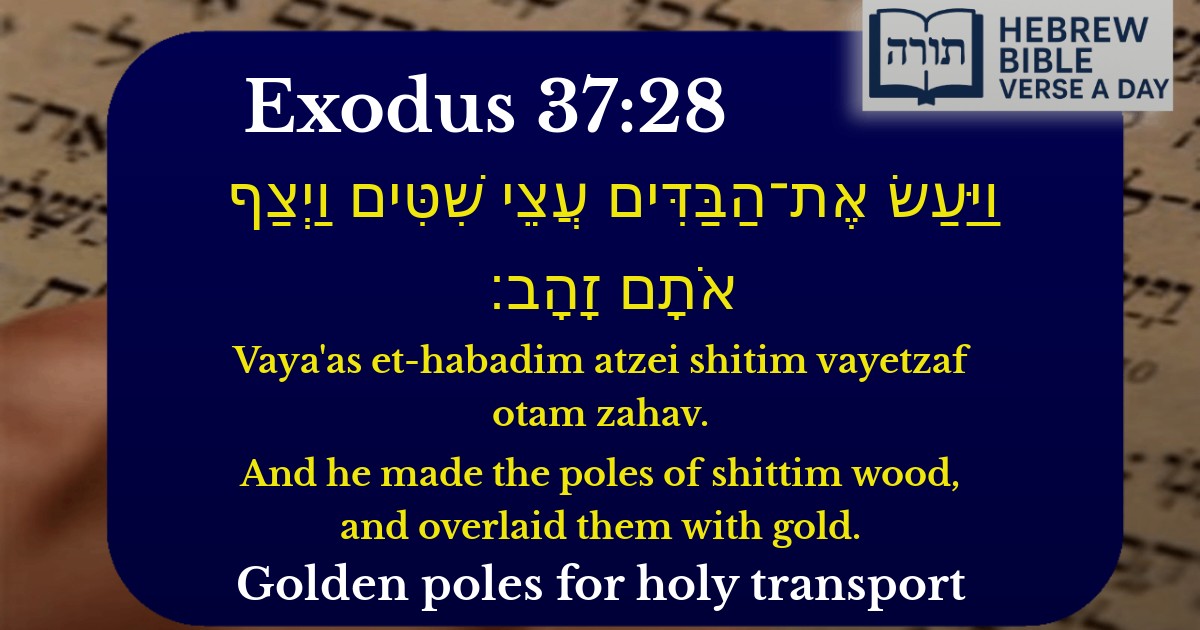Frequently Asked Questions
Q: What are the 'poles' mentioned in Exodus 37:28 used for?
A: The poles (badim) mentioned here were used to carry the golden altar (mizbe'ach hazahav) in the Mishkan (Tabernacle). According to Rashi, these poles were never removed, unlike the poles of the Ark which could be taken out when not in transit (Shemot 25:15).
Q: Why were the poles made from shittim (acacia) wood and covered in gold?
A: Shittim wood was chosen because it was durable and readily available in the wilderness (Midrash Tanchuma, Teruma 9). The gold covering, as explained by Rambam (Hilchot Beit Habechira 1:17), symbolized both beauty and sanctity, showing that even the functional parts of the Mishkan were holy.
Q: What lesson can we learn from the poles being permanently attached to the altar?
A: The permanent attachment teaches that the service of Hashem must always be 'ready to move'—meaning we should be prepared to serve G-d at all times, whether in times of stability or transition (based on Kli Yakar, Shemot 30:4).
Q: Why does the Torah specify the materials (wood and gold) of the poles?
A: The combination of wood (a humble material) and gold (a precious material) teaches balance in avodat Hashem (service of G-d). The wood represents simplicity and accessibility, while the gold represents the highest standards of holiness (based on teachings of the Sefat Emet).
Q: How does this verse connect to the broader construction of the Mishkan?
A: This detail shows the precision in fulfilling Hashem's commands—even the poles were made exactly as instructed (Shemot 25-30). The Talmud (Yoma 72a) derives from this that every part of the Mishkan, even its 'hidden' components, contributed to its sanctity.


The Poles of the Ark: Materials and Symbolism
The verse describes the construction of the poles (badim) for the Ark of the Covenant, made from shittim wood (acacia) and overlaid with gold. This reflects both practical and spiritual dimensions in the construction of the Mishkan (Tabernacle).
Rashi's Explanation
Rashi (Exodus 25:13) notes that the poles were made from shittim wood due to its durability and resistance to decay, ensuring they would last for generations. The overlay of gold symbolizes both the sanctity of the Ark and the need to beautify mitzvot (hiddur mitzvah).
Symbolism of the Materials
Permanence of the Poles
The Talmud (Yoma 72a) teaches that the poles of the Ark were never removed, symbolizing that the Torah is always "portable" and accessible to Israel. Unlike other vessels whose poles were removable, the Ark's poles remained in place, emphasizing the eternal presence of Torah in Jewish life.
Practical Halachic Insight
The Shulchan Aruch (Orach Chaim 154:3) derives from this verse that sacred objects should be treated with dignity, as seen in the care taken to overlay the poles with gold. This principle extends to how we handle Torah scrolls and holy books today.